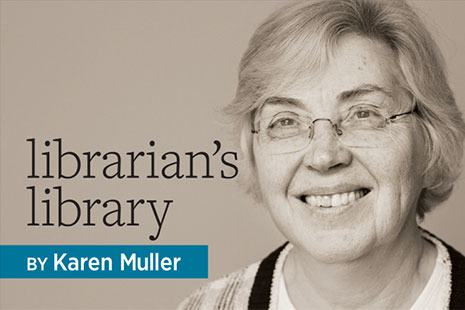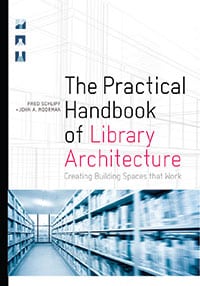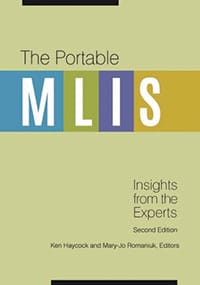
I got in trouble years ago when I told an interviewer that library school doesn’t really prepare students for work in a library. It does, but not completely. MLIS courses aren’t broad enough to include all aspects of the job, or at least to the depth needed once hired. That, of course, makes continued professional development so critical.
 Building or renovating a library is often only cursorily covered. The Practical Handbook of Library Architecture: Creating Building Spaces That Work, by Fred Schlipf and John A. Moorman, is long overdue. Its functional predecessor, Planning Academic and Research Library Buildings, third edition, by Philip D. Leighton and David C. Weber (ALA Editions, 1999), answers many questions about what is needed in the traditional library. But libraries are not traditional anymore. Space is needed for collaborative activities, electronics, programming, and new collection formats. The authors, both experienced librarians and library consultants, start by asking prospective builders or remodelers of libraries to first visit many libraries, critically evaluate everything, and consider what is working and what is not. They offer questions to ask, then follow with a chapter that explains why certain features are not optimal for a library. Subsequent chapters detail what functions the new or renovated space must support, along with numbers that help estimate how much space will be needed. This book will not tell you succinctly how many square feet are needed for a specific number of library users, but it will offer ways to start planning. Information is also included on the role of architects and building consultants, site selection, bidding, construction, costs, and funding, as well as pointers and details on seating, service desks, restrooms, workrooms, and technical components, such as lighting, staircases, HVAC, plumbing, and security. Most important, this book is readable. The authors say things that building planners need to hear and heed. ALA Editions, 2018. 1040 P. $149. PBK. 978-0-8389-1553-0.
Building or renovating a library is often only cursorily covered. The Practical Handbook of Library Architecture: Creating Building Spaces That Work, by Fred Schlipf and John A. Moorman, is long overdue. Its functional predecessor, Planning Academic and Research Library Buildings, third edition, by Philip D. Leighton and David C. Weber (ALA Editions, 1999), answers many questions about what is needed in the traditional library. But libraries are not traditional anymore. Space is needed for collaborative activities, electronics, programming, and new collection formats. The authors, both experienced librarians and library consultants, start by asking prospective builders or remodelers of libraries to first visit many libraries, critically evaluate everything, and consider what is working and what is not. They offer questions to ask, then follow with a chapter that explains why certain features are not optimal for a library. Subsequent chapters detail what functions the new or renovated space must support, along with numbers that help estimate how much space will be needed. This book will not tell you succinctly how many square feet are needed for a specific number of library users, but it will offer ways to start planning. Information is also included on the role of architects and building consultants, site selection, bidding, construction, costs, and funding, as well as pointers and details on seating, service desks, restrooms, workrooms, and technical components, such as lighting, staircases, HVAC, plumbing, and security. Most important, this book is readable. The authors say things that building planners need to hear and heed. ALA Editions, 2018. 1040 P. $149. PBK. 978-0-8389-1553-0.
 Librarians learn the basics of intellectual freedom and can apply the principles to their work, but can definitive statements be quickly found when drafting a rationale? Or even if the MLIS program includes cataloging, are the concepts of information organization clear enough to explain why a new online system is needed? The Portable MLIS: Insights from the Experts, edited by Ken Haycock and Mary-Jo Romaniuk, now in its second edition, is a compendium that provides quick access to important concepts in library service, with references to policy statements and sources for more information. Its essays reinforce key elements of professional practice, from foundations, values, functions, and competencies to reference, evaluation, and marketing. There are useful appendices with policy documents and resources, as well as chapters on careers and other roles for MLIS professionals. Libraries Unlimited, 2017. 378 P. $55. PBK. 978-1-4408-5203-9. (Also available as an ebook.)
Librarians learn the basics of intellectual freedom and can apply the principles to their work, but can definitive statements be quickly found when drafting a rationale? Or even if the MLIS program includes cataloging, are the concepts of information organization clear enough to explain why a new online system is needed? The Portable MLIS: Insights from the Experts, edited by Ken Haycock and Mary-Jo Romaniuk, now in its second edition, is a compendium that provides quick access to important concepts in library service, with references to policy statements and sources for more information. Its essays reinforce key elements of professional practice, from foundations, values, functions, and competencies to reference, evaluation, and marketing. There are useful appendices with policy documents and resources, as well as chapters on careers and other roles for MLIS professionals. Libraries Unlimited, 2017. 378 P. $55. PBK. 978-1-4408-5203-9. (Also available as an ebook.)
 Libraries have been using databases for decades, but the proliferation of online resources has made understanding licensing critical for librarians in all types of libraries and in most roles. Licensing Digital Content: A Practical Guide for Librarians, by Lesley Ellen Harris, now in its third edition, addresses important questions. Harris begins by explaining the need for licensing arrangements when accessing content from an aggregator such as LexisNexis, as well as when authorizing the use of a photographic image owned by the library. She then reviews the basics of the process and terminology, explains the impact of typical clauses, and seeks to clarify the negotiation process. A glossary and checklist for licensing clauses round out the volume. ALA Editions, 2018. 176 P. $65. PBK. 978-0-8389-1630-8.
Libraries have been using databases for decades, but the proliferation of online resources has made understanding licensing critical for librarians in all types of libraries and in most roles. Licensing Digital Content: A Practical Guide for Librarians, by Lesley Ellen Harris, now in its third edition, addresses important questions. Harris begins by explaining the need for licensing arrangements when accessing content from an aggregator such as LexisNexis, as well as when authorizing the use of a photographic image owned by the library. She then reviews the basics of the process and terminology, explains the impact of typical clauses, and seeks to clarify the negotiation process. A glossary and checklist for licensing clauses round out the volume. ALA Editions, 2018. 176 P. $65. PBK. 978-0-8389-1630-8.
 Sometimes libraries just don’t work the way they should, and it is imperative to resolve the issues. In The Dysfunctional Library: Challenges and Solutions to Workplace Relationships, by Jo Henry, Joe Eshleman, and Richard Moniz, the authors look at why a library environment may need remediation. The authors start by recommending that readers reflect on their own behaviors first. They then address incivility in the work environment, staff behaviors that may be adversely affecting team performance, and workplace politics. They also take a long look at skills for conflict management, collaboration, and teamwork, but conclude on a positive note, encouraging constructive leadership norms. ALA Editions, 2018. 216 P. $57.60. PBK. 978-0-8389-1623-0.
Sometimes libraries just don’t work the way they should, and it is imperative to resolve the issues. In The Dysfunctional Library: Challenges and Solutions to Workplace Relationships, by Jo Henry, Joe Eshleman, and Richard Moniz, the authors look at why a library environment may need remediation. The authors start by recommending that readers reflect on their own behaviors first. They then address incivility in the work environment, staff behaviors that may be adversely affecting team performance, and workplace politics. They also take a long look at skills for conflict management, collaboration, and teamwork, but conclude on a positive note, encouraging constructive leadership norms. ALA Editions, 2018. 216 P. $57.60. PBK. 978-0-8389-1623-0.
 As a line professional in a large department, I didn’t need to know much about budgets. As a manager, I had to learn fast. Financial Management in Academic Libraries: Data-Driven Planning and Budgeting, by Robert E. Dugan and Peter Hernon, would have been helpful then. The authors provide fundamental tools for an academic context, with concepts of strategic planning, descriptions of budget types, definitions of costs included in budgets, explanations of where to seek information to help define budgets, and explanations of allocation formulas. There are chapters on managing a budget and reporting results, whether interim or year-end. Unpopular topics such as managing reductions and fraud are also addressed. Each chapter includes both bibliographical references and a bibliography for instances where the overview lacks needed depth. Association of College and Research Libraries, 2017. 200 P. $56. PBK. 978-0-8389-8943-2.
As a line professional in a large department, I didn’t need to know much about budgets. As a manager, I had to learn fast. Financial Management in Academic Libraries: Data-Driven Planning and Budgeting, by Robert E. Dugan and Peter Hernon, would have been helpful then. The authors provide fundamental tools for an academic context, with concepts of strategic planning, descriptions of budget types, definitions of costs included in budgets, explanations of where to seek information to help define budgets, and explanations of allocation formulas. There are chapters on managing a budget and reporting results, whether interim or year-end. Unpopular topics such as managing reductions and fraud are also addressed. Each chapter includes both bibliographical references and a bibliography for instances where the overview lacks needed depth. Association of College and Research Libraries, 2017. 200 P. $56. PBK. 978-0-8389-8943-2.


